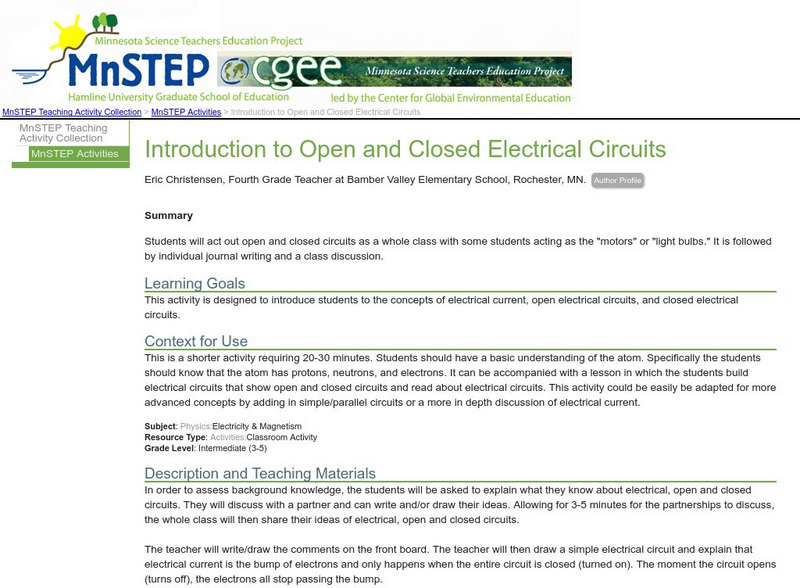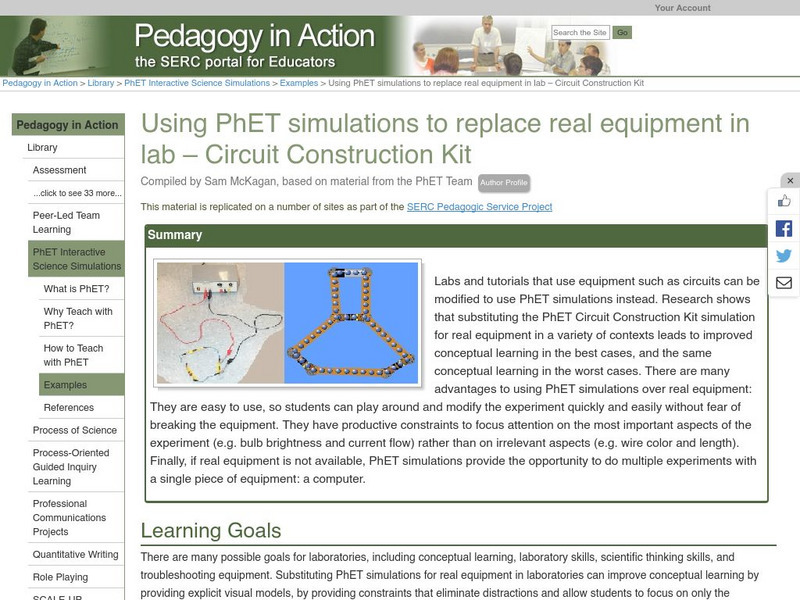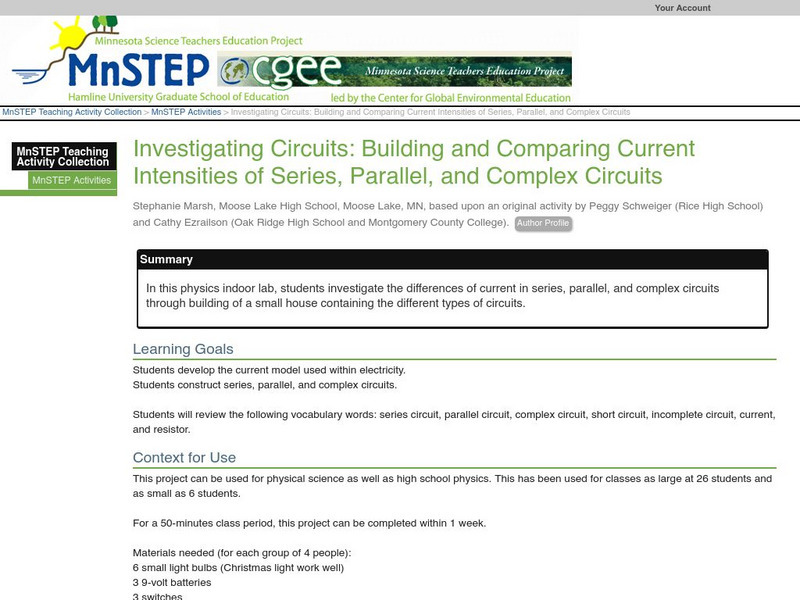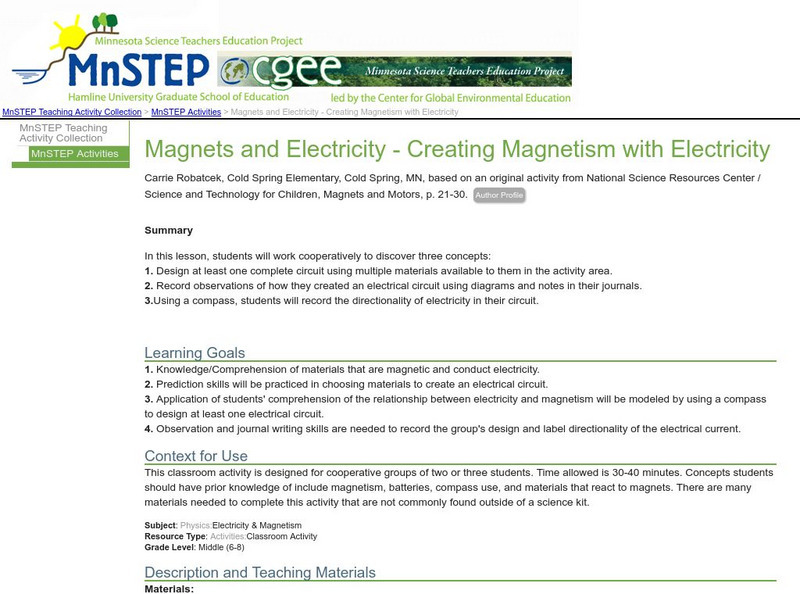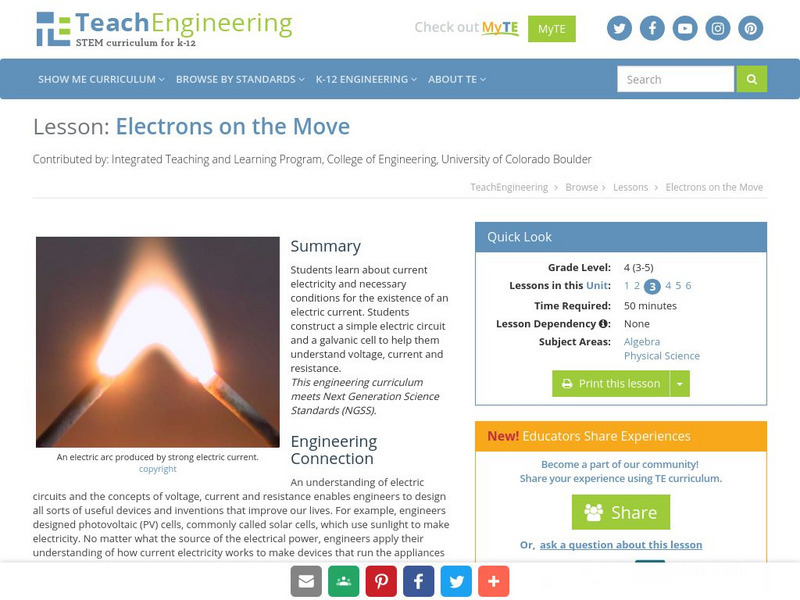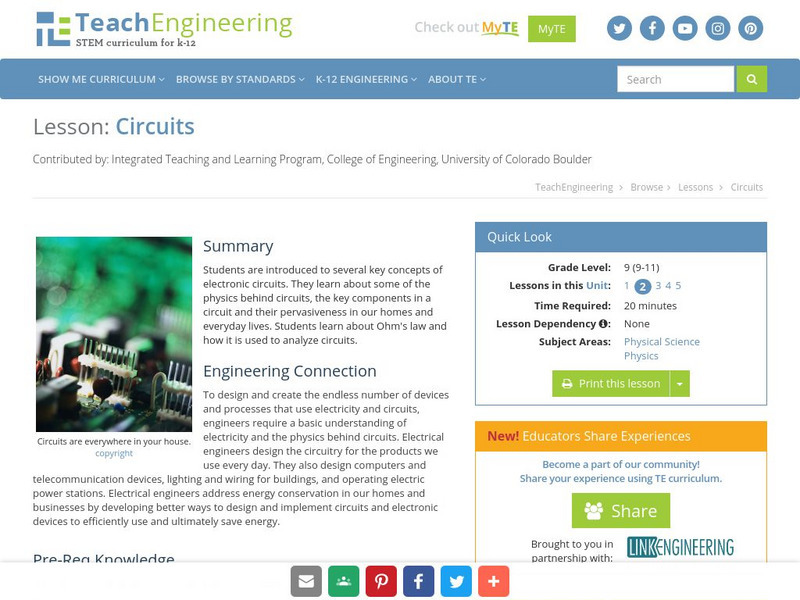TeachEngineering
Teach Engineering: From Sunlight to Electric Current
The lesson plan will first explore the concept of current in electrical circuits. Current will be defined as the flow of electrons. Photovoltaic (PV) cell properties will then be introduced. This will lead to the principle of...
TryEngineering
Try Engineering: Electric Switches
Lesson focuses on how switches control the flow of electricity. Students are posed with the challenge of designing and building a simple switch into an electric circuit.
Science Education Resource Center at Carleton College
Serc: Electric Circuits Guided Inquiry
An electrical circuit guided inquiry where students investigate what an electric circuit is, the main parts of a circuit and the difference between series and parallel circuits. Students groups create a circuit using materials provided...
Science Education Resource Center at Carleton College
Serc: Current Electricity Lights On
An exploratory lesson that provides the learners with a chance to discover the possible connections in an electrical circuit in a controlled setting.
Science Education Resource Center at Carleton College
Serc: Introduction to Open and Closed Electrical Circuits
This activity introduces students to the concepts of electrical current and open and closed circuits. Students will act out open and closed circuits as a whole class with some students acting as the "motors" or "light bulbs."
Science Education Resource Center at Carleton College
Serc: Ph Et Simulations: Replace Real Equipment in Lab Circuit Construction Kit
Students explore with a PhET interactive simulation to replicate the construction of electrical circuits.
Science Education Resource Center at Carleton College
Serc: Comparing Current Intensities of Series, Parallel, and Complex Circuits
Learners will investigate the differences of current in series, parallel, and complex circuits through the construction of a small house containing the different types of circuits.
Utah Education Network
Uen: Flowing Electrons
For this fifth grade activity, students explore electric circuits by acting out different types, then construct circuits themselves.
Science Education Resource Center at Carleton College
Serc: Magnets and Electricity: Creating Magnetism With Electricity
Students will work in small groups to design at least one complete circuit using multiple materials. They will record their observations of how they created an electrical circuit using diagrams and notes in their journals. Using a...
Science Education Resource Center at Carleton College
Serc: Investigating Electricity
For this interactive activity, students will explore electricity and be able to design and create a complete electrical circuit. Students will also learn what is necessary to light a light bulb. Creative thought, ideas, and,...
TryEngineering
Try Engineering: Series and Parallel Circuits
The core of this lesson plan is simple circuits and the differences between parallel and series circuit design. Students perform experiments to test the differences between the two circuit designs using low voltage light bulbs.
Science Education Resource Center at Carleton College
Serc: Investigating Electricity: Building Circuits in Elementary Science Class
In this exploration activity, students compare the difference between series circuits and parallel circuits using wire, light bulbs, and D batteries.
Science and Mathematics Initiative for Learning Enhancement (SMILE)
Smile: Electron Current Flow
A teacher lesson plan which could be easily converted into an idea for a student project or presentation. This page describes an activity in which the water-electricity analogy is used to investigate the relationship between current,...
Science and Mathematics Initiative for Learning Enhancement (SMILE)
Smile: Series and Parallel Circuits
A teacher lesson plan which could be easily converted into an idea for a student project or presentation. Ideal for pre-high school students. This page describes an activity in which the history of electric circuits, the nature of...
TeachEngineering
Teach Engineering: Electrons on the Move
Students learn about current electricity and necessary conditions for the existence of an electric current. Students construct a simple electric circuit and a galvanic cell to help them understand voltage, current and resistance.
TeachEngineering
Teach Engineering: Circuits
Students are introduced to several key concepts of electronic circuits. They learn about some of the physics behind circuits, the key components in a circuit and their pervasiveness in our homes and everyday lives. Students learn about...
TeachEngineering
Teach Engineering: Electrifying the World
This lesson introduces students to the fundamental concepts of electricity. This is accomplished by addressing questions such as "How is electricity generated," and "How is it used in every-day life?" The lesson also includes...
Science and Mathematics Initiative for Learning Enhancement (SMILE)
Smile: Electric Currents and Circuits
This cooperative learning activity for intermediate to junior high students has them create various electrical circuits in order to understand electricity.
Science and Mathematics Initiative for Learning Enhancement (SMILE)
Smile: Resistances in Series and Parallel Circuits
A teacher lesson plan is provided here. This page describes two activities in which the effect of multiple resistors on the current and overall resistance of both series and parallel circuits are investigated. Complete activity...
Science and Mathematics Initiative for Learning Enhancement (SMILE)
Smile: Simple Circuitry and Series Circuit
A teacher lesson plan which could be easily converted into an idea for a student project or presentation. This page describes an activity in which the basic nature of a circuit and the concepts of a series circuit are investigated....
Science Education Resource Center at Carleton College
Serc: Investigating Testing for Electrical Conductivity Using Materials
In this activity, learners will understand that electricity moves through different circuits and discover what types of materials are conductors and insulators.
Science and Mathematics Initiative for Learning Enhancement (SMILE)
Smile: Ohm's Law
For the teacher planning a lesson or for the student preparing for a project or presentation. This page describes a series of simple activities related to the voltage-current-resistance relationship.
Science and Mathematics Initiative for Learning Enhancement (SMILE)
Smile: Electrochemistry
A teacher lesson plan which could be easily converted into an idea for a student project or presentation. This page describes activities in which the interconversion of chemical and electrical energy are investigated. Complete activity...
Science and Mathematics Initiative for Learning Enhancement (SMILE)
Smile: Electromagnets
This lesson plan contains several activities designed to help the student understand the magnetic effects of an electrical current.




